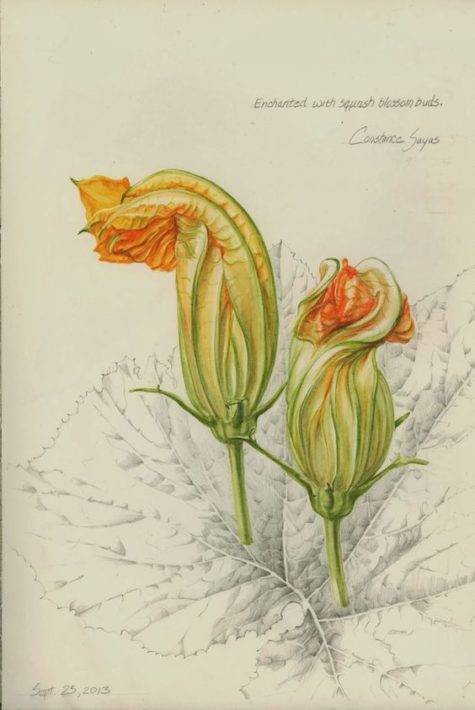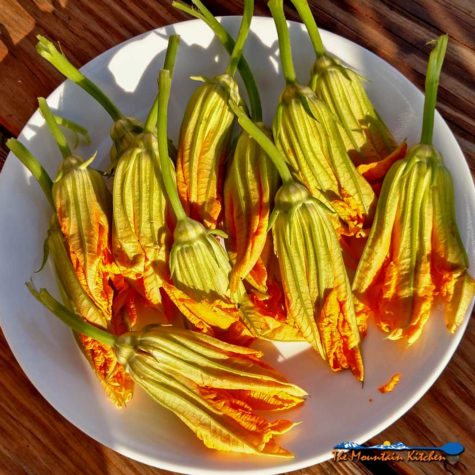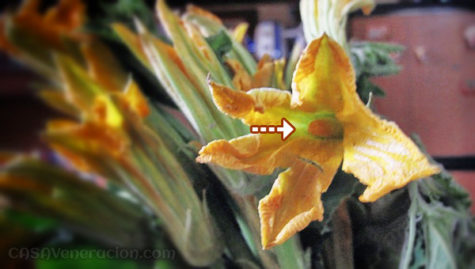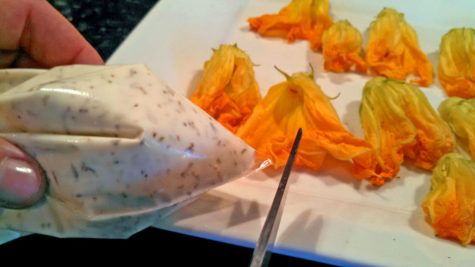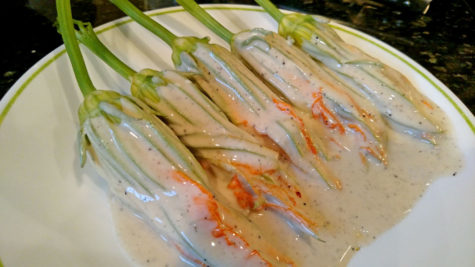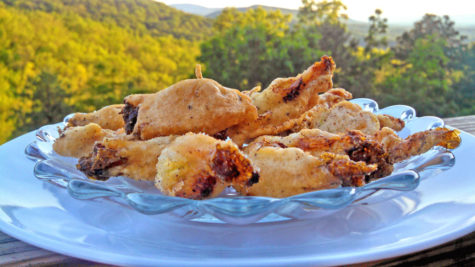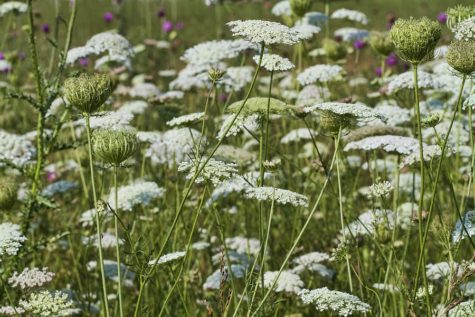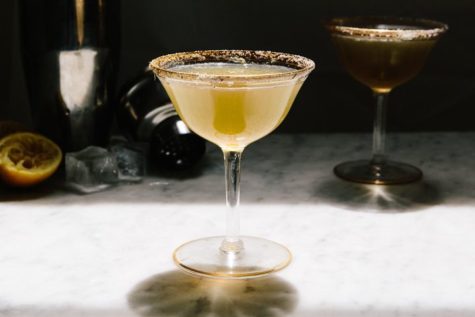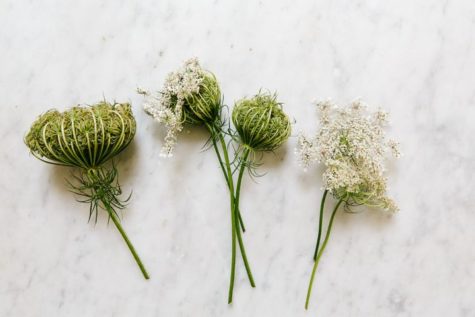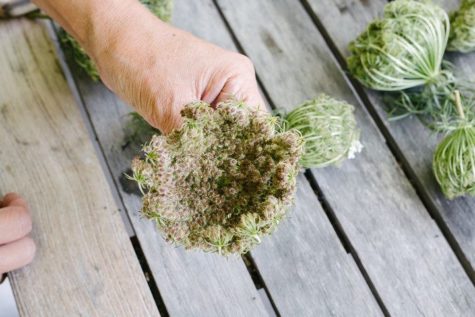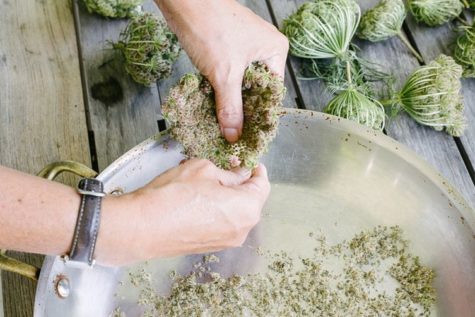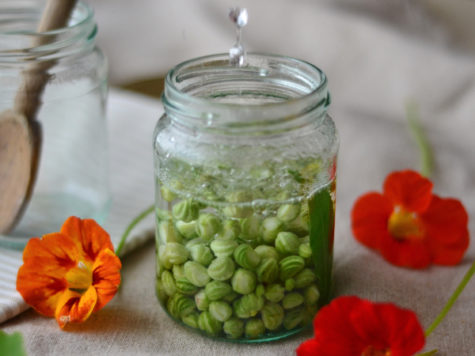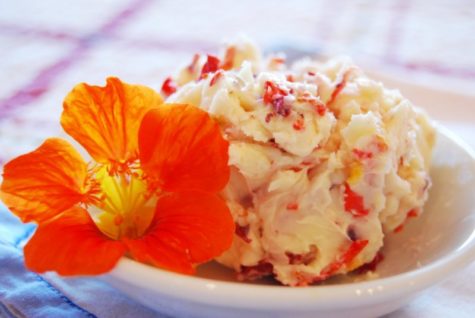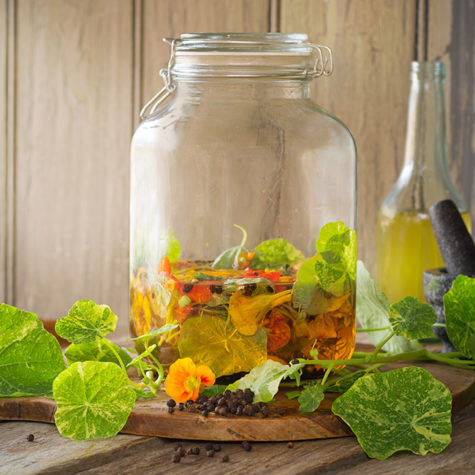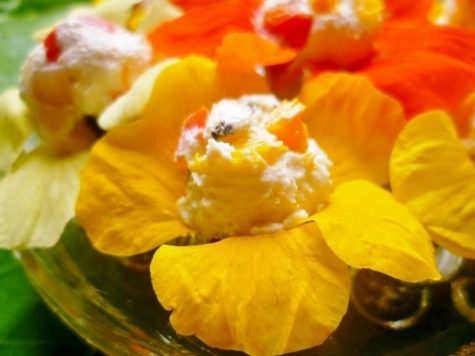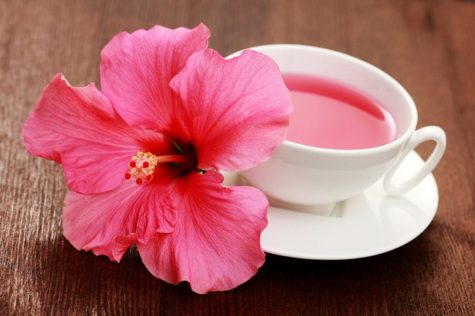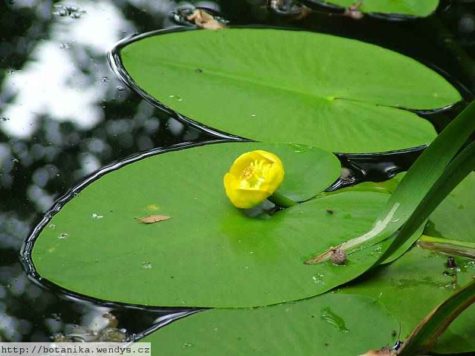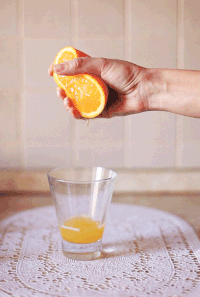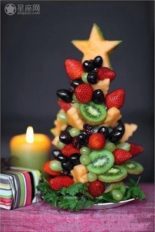Edible Flowers
Fried Squash Blossoms Stuffed With Cheese
Before I share this recipe with you, I want to help you select the blooms.
Use the blossoms from zucchini, or pumpkin. Other squash flowers may have strong, unpleasant flavors. Harvest the male flowers once they have just opened. The male flowers have stems and you can tell them from females, because the females are attached to the squash. They also go on to say that you should use them as soon as possible, but I have found that the blossoms are not as delicate as they seem. In fact, I have actually left them inside and uncovered carton in the refrigerator a couple of days and still find them easy to work with if not better.
Don’t worry, if you don’t have the luxury of growing your own squash, and you can’t find them, ask one of the farmers for flowers at your local farmers’ market or in specialty food stores. If they have zucchini on their farm stand, they’ll have blooms on their farm. I just so happen to know that farmers don’t bite and they will be happy to help you get some blossoms. Just ask!
Fried squash blossoms are practically a delicacy! The delicate squash blossoms are filled with a well seasoned creamy ricotta cheese, dipped in a light batter and fried to a crispy golden brown. If you have your own garden and zucchini are starting to run out of your ears this summer, here’s something different you can try. Prepare them as unique appetizer or as a side dish this summer for family and friends.
Here’s how you make them:
These delicate fried squash blossoms are filled with a creamy ricotta cheese mixture and dipped in a light batter, fried to a golden brown. They’re amazing! |
Ingredients:
- ¾ cup cornstarch
- 1 teaspoon baking powder
- ¼ teaspoon fresh cracked black pepper
- ¼ cup all-purpose flour
- ½ teaspoon season salt
- ½ cup water
- 1 egg, slightly beaten
- 10 to 15 squash blossoms
- ½ cup ricotta cheese
- ¼ cup mayonnaise
- 1 teaspoon dried oregano
- ½ teaspoon garlic powder
- 1 tablespoon bread crumbs
- peanut, canola or vegetable oil, for frying
- Kosher salt and fresh cracked black pepper, to taste
The batter:
Combine cornstarch, baking powder, pepper, flour, then season with salt. Stir in the egg and water until smooth. Store in the refrigerator for 15 to 20 minutes before frying.
The blossoms:
While the batter is chilling, prepare the squash blossoms.
Use your fingers to carefully separate the flower petals without breaking them and remove the pistil in the center. Rinse the flowers under cold water, paying attention not to damage petals. Lay them spaced out on a paper towel and gently pat dry.
The cheese:
Combine the cheese, mayonnaise, oregano, and breadcrumbs until smooth.
Pour the filling inside a piping bag or use a plastic storage bag and cut the tip off one corner, so that you can carefully add about a tablespoon of this mixture to each blossom and twist the top of the flower tight.
Frying them up:
Heat enough oil in a frying pan to accommodate the blossoms (about 1 inch deep). Get the batter out of the fridge and dip each blossom in batter, coating it.
When the oil is hot, carefully place each batter-covered blossom in the hot oil and fry until golden crisp on both sides.
- Be careful! This batter contains a little water, which tends to make it pop and spatter a little more than usual.
Remove the blossoms and drain on paper towels; sprinkle with salt and pepper, while hot.
Allow to cool for about 5 minutes. Serve warm. Makes: 15.
From: The Mountain Kitchen
Queen Anne’s Lace Jelly
- 18 large Queen Anne’s lace heads
- 4 Cups water
- ¼ Cup lemon juice (fresh or bottled)
- 1 Package powdered pectin
- 3 ½ Cups + 2 Tbsp. sugar
Bring water to boil. Remove from heat. Add flower heads (push them down into the water). Cover and steep 30 minutes. Strain.
Measure 3 cups of liquid into a 4 – 6 quart pan. Add lemon juice and pectin. Bring to a rolling boil stirring constantly. Add sugar and stir constantly. Cook and stir until mixture comes to a rolling boil. Boil one minute longer, and then remove from heat.
Add color (pink) if desired. Skim. Pour into jars leaving ¼” head space. Then process in a hot water bath for 5 minutes.
Makes about 6 jars
Important Notice:
Historically, Queen Anne’s lace was used for medicinal and contraceptive purposes. Avoid it if you are pregnant, and check with your doctor if you are currently taking medications. More information about this wild herb can be found here: Encyclopedia of Herbology – Wild Carrot
The carrot family contains a number of poisonous look-alikes, most notably poison hemlock. Once the fruit has formed, it is easy to tell them apart, but less so when the plants still only have leaves.
When foraging, always choose high-quality landscapes (not next to the highway or on post-industrial or sprayed sites), and make sure to obtain permission if it is not your own yard. If possible, go out with an experienced forager.
Found at: Herbal Riot
Queen Anne’s Lace Cognac Apéritif
On late-summer evenings, I take the chill off with a cognac apéritif, the rim of the glass dipped in spicy Queen Anne’s Lace.
For the rim:
- 3 tablespoons dried Queen Anne’s Lace fruits
- 1 1/2 tablespoons fine sugar
Crush the dried Queen Anne’s Lace fruits with the sugar and mix thoroughly. (To save effort for multiple drinks, we made a larger batch with the same 2:1 ratio.) Spread the mixture on a saucer or plate that is larger than the diameter of the glass rim. Moisten the rim of the glass by dipping it upside down in a shallow bowl of water and let the excess water drip off for a few seconds. Dip the moistened rim in the Queen Anne’s Lace/sugar mixture, pressing down firmly. The mixture should cling to the rim where moistened. Gently shake off any excess.
Note: Instructions on collecting the Queen Anne’s Lace fruits can be found here: Queen Anne’s Lace
For the drink:
- 2 ounces cognac (I suggest Pierre Ferrant 1840)
- 3/4 ounce fresh Meyer lemon juice or bergamot juice
- 3/4 ounce honey syrup (equal parts honey and hot water)
- 1 teaspoon dried Queen Anne’s Lace fruit
In a cocktail shaker, combine cognac, lemon juice syrup, and ice. Shake vigorously for half a minute or until chilled. Pour the mixture through a strainer (to remove the Queen Anne’s Lace bits) and into the rimmed glass. Serve immediately.
Makes 1
Important Notice:
Historically, Queen Anne’s lace was used for medicinal and contraceptive purposes. Avoid it if you are pregnant, and check with your doctor if you are currently taking medications. More information about this wild herb can be found here: Encyclopedia of Herbology – Wild Carrot
The carrot family contains a number of poisonous look-alikes, most notably poison hemlock. Once the fruit has formed, it is easy to tell them apart, but less so when the plants still only have leaves.
When foraging, always choose high-quality landscapes (not next to the highway or on post-industrial or sprayed sites), and make sure to obtain permission if it is not your own yard. If possible, go out with an experienced forager.
Found at: Food 52
Queen Anne’s Lace
Queen Anne’s Lace looks delicate, but its fruit’s pungent flavor and spice is anything but dainty. The flowers of the wild carrot, or Queen Anne’s Lace, are as edible as the stringy root — but the culinary gem is its fruit. Because each fruit is so small and the harvest window is relatively short, I hadn’t even noticed them until recently. But when I looked closely, I could see that each cluster was full of hundreds of small, eye-shaped fruits.
I picked the bunches with the largest fruit (some of the fruit was red, and some was still green), checking the aroma by breathing deep into their flower nests. The scent can vary, but they are heavily fragrant — oftentimes peppery with hints of coriander and carrot. This complexity is the essence of wild flavors.
To harvest, clip the cluster, remove the fruits from the frame, and dry them under gentle heat (such as a heat lamp or dehyrdrator); you can store them whole to use as a spice or seasoning at will. Once they dry, their strong aroma will dissipate, but give them a quick grind in the Cuisinart, blender, or mortar and pestle and — violà! — the pungent fragrance returns.
One of my favorite ways to use this spice is to sprinkle it on top of carrot cake for an added kick. It’s also wonderful in carrot salads, caramelized on top of crème brulée, or infused into jelly.
Important Note:
Historically, Queen Anne’s lace was used for medicinal and contraceptive purposes. Avoid it if you are pregnant, and check with your doctor if you are currently taking medications. More information about this wild herb can be found here: Encyclopedia of Herbology – Wild Carrot
The carrot family contains a number of poisonous look-alikes, most notably poison hemlock. Once the fruit has formed, it is easy to tell them apart, but less so when the plants still only have leaves.
When foraging, always choose high-quality landscapes (not next to the highway or on post-industrial or sprayed sites), and make sure to obtain permission if it is not your own yard. If possible, go out with an experienced forager.
Found at: Food 52
Pickled Nasturtium Seeds
Use green nasturtium seeds, and in picking retain a short length of stem on each. Lay the seeds in cold salted water for two days (two tablespoons salt to one quart water), then place them in cold water for another day. Drain well and place the seeds in a glass jar, cover with vinegar heated to the boiling point, and close the jar tightly. In a few days the seeds will be ready to use. They are an excellent substitute for capers.
From: Herbal Gardens
Nasturtium Lemon Butter
This lovely butter has a mild lemon/pepper flavor and a colorful appearance. It is wonderful on fish, chicken and vegetables. This is also great on those small party breads, pumpernickel especially.
- 1/2 cup unsalted butter softened
- 1-2 teaspoons grated lemon peel (according to taste)
- 1 tablespoon lemon juice
- 3 tablespoons finely chopped nasturtium blossoms
Mix all of the ingredients well until smooth and well blended. Refrigerate or freeze until ready to serve. Makes 3/4 cup flavored butter.
From: Herbal Gardens
Nasturtium Vinegar
Nasturtiums have a wonderful peppery flavor and add zest to any recipe.
- 1 cup nasturtium leaves, flowers, and buds
- 1 pint champagne or white wine vinegar
Place the ingredients in a clean clear glass jar or bottle. Tightly seal. Let sit for at least 3 weeks before using. Place a new nasturtium in the finished bottle for decoration, but you should make sure the vinegar always covers the flowers or they will mold. Makes 1 pint vinegar to use in salads, sauces and flavoring in other dishes.
From: Herbal Gardens
Stuffed Nasturtium Flowers
Nasturtium flowers have a wonderful peppery flavor.
Mix 8 ounces softened cream cheese with 2 Tablespoons finely minced chives or other herbs of your choice. Stuff the mixture into nasturtium flowers and place on a tray that has been lined with nasturtium leaves. Serve at room temperature.
From: Herbal Gardens
Summer Tea
This tea is refreshing on any warm day or after exertion in the garden. It is equally pleasant hot or cold.
- 2 tsp hibiscus flowers
- grated peel of ½ a lemon (optional)
- grated peel of ½ a lime (optional)
Note:
This blend is for one person and is intended to have half a pint of boiling water poured over it. Allow the infusion to stand for 10 minutes before straining and do not stir, as this bruises the plants. Obviously, you can adjust the amount of water or standing time to your own taste. If you prefer your tea sweet, add a little honey, not sugar, to the strained infusion.
Pond Lily Popcorn
You can eat the seeds of yellow pond lily (Nuphar lutea) also called spatterdock, yellow water-lily, or cow lily. Here’s a recipe from Janice Schofield, an Alaskan herbalist:
Pop 1/4 cup of seeds in 2 tablespoons of oil and flavor with butter, nutritional yeast and whatever else you fancy. The Assiniboin and Micmac peoples ate them: fried in bear fat.
Enjoy!
